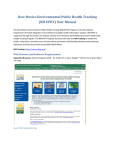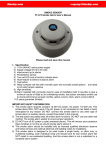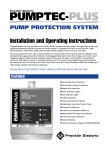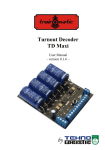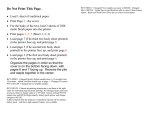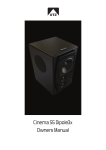Download Harbor Freight Tools 39178 User's Manual
Transcript
450 Lb. Capacity Transmission Jack 39178 ASSEMBLY AND OPERATING INSTRUCTIONS Note: This tool requres a 1/2” Drive Ratchet or Breaker Bar to operate (neither one included). 3491 Mission Oaks Blvd., Camarillo, CA 93011 Visit our Web site at http://www.harborfreight.com TO PREVENT SERIOUS INJURY, READ AND UNDERSTAND ALL WARNINGS AND INSTRUCTIONS BEFORE USE. Copyright© 2004 by Harbor Freight Tools®. All rights reserved. No portion of this manual or any artwork contained herein may be reproduced in any shape or form without the express written consent of Harbor Freight Tools. For technical questions and replacement parts, please call 1-800-444-3353 Specifications Maximum Load Capacity 450 lbs. Cradle Size 6-7/8" x 13" Lift Range 7-1/4" to 22-1/2" Leadscrew Thread 5/8" diameter acme thread type Swivel Casters Non-marring Ball Bearing Nylon Strap 2" wide x 43" long Net Weight 33.25 lbs. Overall Size 16-1/2" x 15-5/8" x 8" Note: This tool requres a 1/2” Drive Ratchet or Breaker Bar to operate (neither one included). Save This Manual You will need the manual for the safety warnings and precautions, assembly instructions, operating and maintenance procedures, parts list and diagram. Keep your invoice with this manual. Write the invoice number on the inside of the front cover. Keep the manual and invoice in a safe and dry place for future reference. Safety Warnings and Precautions WARNING: When using tool, basic safety precautions should always be followed to reduce the risk of personal injury and damage to equipment. Read all instructions before using this tool! 1. Keep work area clean. Cluttered areas invite injuries. 2. Observe work area conditions. Do not use machines or power tools in damp or wet locations. Don’t expose to rain. Keep work area well lighted. 3. Keep children away. Children must never be allowed in the work area. Do not let them handle machines, tools, or extension cords. 4. Store idle equipment. When not in use, tools must be stored in a dry location to inhibit rust. Always lock up tools and keep out of reach of children. 5. Use the right tool for the job. Do not attempt to force a small tool or attachment to do the work of a larger industrial tool. There are certain applications for which this tool was designed. It will do the job better and more safely at the rate for which it was intended. Do not modify this tool and do not use this tool for a purpose for which it was not intended. 6. Dress properly. Do not wear loose clothing or jewelry as they can be caught in moving parts. Protective, clothes and non-skid footwear are recommended when working. Wear restrictive hair covering to contain long hair. SKU 39178 Page 2 7. Use eye and ear protection. Always wear ANSI approved impact safety goggles. Wear an ANSI approved dust mask or respirator when working around metal, wood, and chemical dusts and mists. 8. Do not overreach. Keep proper footing and balance at all times. Do not reach over or across running machines. 9. Maintain tools with care. Keep tools sharp and clean for better and safer performance. Follow instructions for lubricating and changing accessories. The handles must be kept clean, dry, and free from oil and grease at all times. 10. Remove adjusting keys and wrenches. Check that keys and adjusting wrenches are removed from the tool or machine work surface before operating. 11. Avoid unintentional lowering. Keep feet and hands away from the pump pedal and release pedal when you are not prepared to raise or lower the jack. 12. Stay alert. Watch what you are doing, use common sense. Do not operate any tool when you are tired. 13. Check for damaged parts. Before using any tool, any part that appears damaged should be carefully checked to determine that it will operate properly and perform its intended function. Check for alignment and binding of moving parts; any broken parts or mounting fixtures; and any other condition that may affect proper operation. Any part that is damaged should be properly repaired or replaced by a qualified technician. 14. Replacement parts and accessories. When servicing, use only identical replacement parts. Use of any other parts will void the warranty. Only use accessories intended for use with this tool. Approved accessories are available from Harbor Freight Tools. 15. Do not operate tool if under the influence of alcohol or drugs. Read warning labels on prescriptions to determine if your judgment or reflexes are impaired while taking drugs. If there is any doubt, do not operate the tool. 16. Maintenance. For your safety, service and maintenance should be performed regularly by a qualified technician. 17. Do not exceed the weight limit of this jack. Overloading the jack may result in unexpected, rapid lowering of the object being held, as well as damage to the jack itself. Serious injury and property damage may result. 18. Assure that any load being supported by this jack is well balanced. Unbalanced loads may cause the jack to fall over potentially causing serious personal injury or property damage. SKU 39178 Page 3 19. This jack is not to be used for any aircraft purposes. 20. Jack to be used on a flat, level surface capable of supporting the weight of the jack, the workpiece and related tools Warning: The warnings, cautions, and instructions discussed in this instruction manual cannot cover all possible conditions and situations that may occur. It must be understood by the operator that common sense and caution are factors which cannot be built into this product, but must be supplied by the operator. Unpacking When unpacking, check to make sure the following parts are included. (1) Jack Assembly (4) Caster Wheel Sets with hardware If any parts are missing or broken, please call Harbor Freight Tools at the number on the cover of this manual. Assembly Prepare for assembly by having a clean, well lit location. You will need a small open-end or adjustable wrench (not included) to complete assembly. 1) Locate the four Casters Assemblies (16), four Nuts (14) and four Spring Washers (15). Attach a Caster to each of the legs on the Base Assembly (13) using these as shown in the Assembly Diagram. Tighten securely. WARNING: Do not overload this jack. The jack may be damaged, and you may experience unplanned, rapid lowering of the load. This may cause severe personal injury or property damage. WARNING: Do not carry an unbalanced load, or a load not appropriate to the designed use of this jack. The jack may topple over causing serious personal injury or property damage. WARNING: Be aware of dynamic loading! A sudden start or jerk on the jack may create for a brief instant, an excess load, which may result in damage to the product and/or personal injury. SKU 39178 Page 4 Operation WARNING: Before standing or working underneath any elevated vehicle or other object, be sure that the vehicle is properly and safely secured following recommendations of the lift manufacturer. For your safety and the safety of others, use good professional practice and common sense. Only use on a flat, level surface capable of supporting the weight of the jack, the workpiece and related tools. 1) The jack may easily be moved by rolling it on its casters. Locate the jack under the transmission. Using a 1/2” Drive Ratchet or Breaker Bar (neither one included) engaged in Bushing (35), rotate the Screw Rod (29) clockwise in order to raise the jack until the Saddle (3) nearly contacts the underside of the transmission. Adjust the position of the jack so that it is centered directly under the center of gravity of the transmission. 2) It is important for your safety to get a good contact between the Saddle (3) and the transmission. This will assure that the transmission is properly supported and balanced once removed from the vehicle and on the jack. Loosen the Wing Nuts (5) and raise the jack again until the Saddle (3) contacts the transmission and presses slightly against it. 3) Secure the transmission to the Saddle (3) by passing the Ratchet Tie-down (7) over the top of the transmission, and securing it using the buckle. Be sure that it is tight. Please review section on Ratchet Tie-down operation next page. Tighten the Wing Nuts (5) and raise the jack until the transmission’s weight is supported by it. 4) Remove the bolts and fittings attaching the transmission to the vehicle, as recommended by the vehicle’s repair instructions. 5) Lower the transmission slightly by turning the Bushing (35) counterclockwise. Recheck the transmission to assure that it is securely and safely attached to the Saddle (3). Make any necessary adjustments. When it is safe to do so, lower the transmission all the way by turning the Bushing (35). For safety, 2 people should be working together to perform these operations. 6) While stabilizing the transmission on the jack, roll the transmission out from under the vehicle to the work location where it will be repaired. It is a good idea to have an assistant help you lower and move the transmission. WARNING: The use of this jack is limited to the removal, installation, and transportation in the lowest position, of transmissions and differentials. Do not store the transmission or any other part on the jack,unless the jack is in the lowered position. However, the jack is not appropriate as a long-term storage device. Never move the jack unless it is in its lowest position. Do not overload. Overloading can cause damage to the jack and cause consequential personal or property injury. This jack is designed to use only on hard, level surfaces capable of supporting the load. Use on other surfaces may cause instability and possible property damage or personal injury. SKU 39178 Page 5 Ratchet Tie-down Operation The Ratchet Tie-down (7) is used to secure the transmission to the jack to prevent the transmission from falling off during use. 1) To secure the transmission to the jack, first pass the belt over the top of the transmission. Be sure the belt is not twisted, and is not pressing on any part of the transmission that might be damaged, such as the speedometer cable fitting, etc. 2) Pass the end of the belt through the ratchet behind the reel, and through the slot in the reel, as shown in the photo. 3) Tighten the belt by pressing the ratchet handle repeatedly downward, as shown in the photo. 4) When preparing to remove the Tiedown, have an assistant stabilize the transmission on the jack to keep it from falling. 5) To remove the belt: Pull release tab A away from the spool and swing the upper handle wide open until it rests on the raised portion of the flanges, as shown in the photo to the left. WARNING: Keep your fingers clear of the spool when releasing the ratchet; it will rotate as the belt is released. When the belt is loosened, pull it out of the buckle and remove the belt. Flange Release Tab A Release Tab B Maintenance 1) The mechanical parts of the jack, such as the Screw Rod (29) and hinge pins of the Adjustable Frame (10) should occasionally be lubricated with heavy oil or grease. 2) Maintain and store the jack in a reasonably protected environment. Do not expose to rain or excess moisture. Protect from salt water or other corrosive materials. If it becomes dirty, clean it promptly with clean water or a suitable detergent. Be aware that using a pressure washer to clean it may remove some paint from the outer surface. Be sure to lubricate (outlined above) after cleaning. SKU 39178 Page 6 Parts List No. Description Qty. No. Description Qty. 1 Bearing 2 19 Lock Plate 1 2 Screw Shaft 1 20 Washer 6mm 1 3 Saddle 1 21 Wing Nut m6 1 4 Washer m10 2 22 Spring Washer m10 2 5 Wing Nut m10 2 23 Nut m10 2 6 Bolt m8 x 70 2 24 Cover Plate 1 7 Ratchet Tie-down 1 25 Steel Ball 8 Nut m8 2 26 Bushing 1 9 Bolt m10 x 50 2 27 Cotter m3.2 x 36 1 10 Adjustable Frame 1 28 Slotted Nut 1 11 Bearing 2 29 Screw Rod 1 12 Plate Assembly 1 30 Nut m8 1 13 Base Assembly 1 31 Set Screw m8 x 20 1 14 Nut m12 4 32 Bushing 1 15 Washer m12 4 33 Cover Plate 1 16 Caster Assembly 4 34 Bushing 1 17 Bolt m10 x 50 2 35 Bushing 1 18 Bolt m6 x 12 1 40 NOTE: Some parts are listed and shown for illustration purposes only and are not available individually as replacement parts. PLEASE READ THE FOLLOWING CAREFULLY THE MANUFACTURER AND/OR DISTRIBUTOR HAS PROVIDED THE PARTS DIAGRAM IN THIS MANUAL AS A REFERENCE TOOL ONLY. NEITHER THE MANUFACTURER NOR DISTRIBUTOR MAKES ANY REPRESENTATION OR WARRANTY OF ANY KIND TO THE BUYER THAT HE OR SHE IS QUALIFIED TO MAKE ANY REPAIRS TO THE PRODUCT OR THAT HE OR SHE IS QUALIFIED TO REPLACE ANY PARTS OF THE PRODUCT. IN FACT, THE MANUFACTURER AND/OR DISTRIBUTOR EXPRESSLY STATES THat ALL REPAIRS AND PARTS REPLACEMENTS SHOULD BE UNDERTAKEN BY CERTIFIED AND LICENSED TECHNICIANS AND NOT BY THE BUYER. THE BUYER ASSUMES ALL RISK AND LIABILITY ARISING OUT OF HIS OR HER REPAIRS TO THE ORIGINAL PRODUCT OR REPLACEMENT PARTS THERETO, OR ARISING OUT OF HIS OR HER INSTALLATION OF REPLACEMENT PARTS THERETO. SKU 39178 Page 7 Assembly Drawing SKU 39178 Page 8








